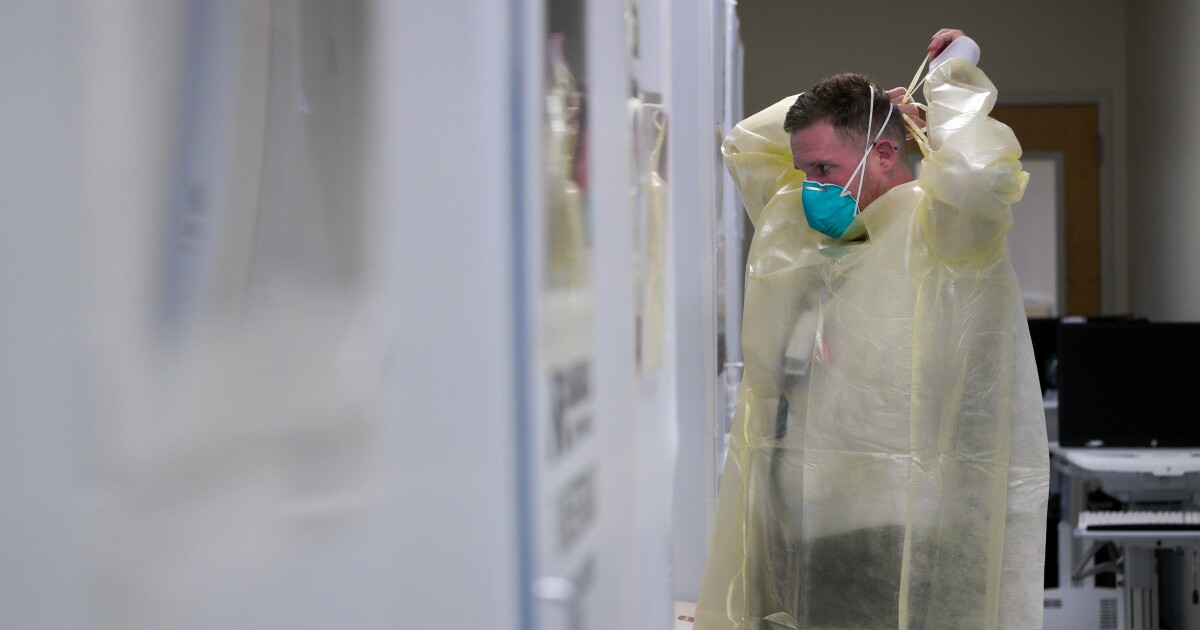
San Diego County hospitals reported a relentless upward trend in COVID-19 patient admissions Monday just as the governor warned that a similar situation statewide will soon spur “deep purple moves” in places where coronavirus is causing the most mayhem.
In a midday news conference, Gov. Gavin Newsom warned that his administration has been talking to public health directors in places where the virus is hitting hospitals especially hard, such as San Francisco and Los Angeles.
He said modeling indicates that the number of COVID-19 cases in California hospitals could be two to three times higher than it is today by Christmas if residents do not get serious about wearing masks and other measures that, when broadly adopted, have the power to slow the spread of the virus.
Places already in the most-restrictive purple tier of the state’s COVID-19 risk-ranking system can expect to undergo more significant restrictions in coming days, the governor said. Think deep purple, and not the 1970s rock band.
Expect a level of restrictions “that is more equivalent, more in line, with the stay-at-home order that folks were more familiar with in the beginning of this year,” he said.
For those whose memories have gotten a bit hazy about how it was in March, April and May, think closed beaches, no haircuts and certainly no restaurant dining, indoor or outdoor.
San Diego County has so far not made any moves to curtail such activity despite more aggressive moves in Los Angeles and some Bay Area communities. Public health officials declined to comment on the governor’s statements Monday but are scheduled to hold their regular weekly news conference Wednesday.
The situation with local hospitals continues to look more dire by the day with the number of COVID-19 patients in beds across San Diego County reaching 692 Sunday. A separate count kept by the Hospital Association of San Diego and Imperial Counties hit 732 Monday afternoon, though that figure includes local military hospitals while the county count does not.
Another 959 confirmed cases were added to the local pandemic total, a number that would have been shocking three weeks ago but instead looked like a bit of a down day after record-setting totals in the 1,800s Thursday and Friday. For the second-straight day, no additional deaths were reported, though there has generally been a weekend lag due to delays in paperwork processing.
It was not all bad news Monday.
Newsom said he had learned that California will receive about 327,000 doses of coronavirus vaccine in the “next few weeks” from Pfizer, the first company expected to receive emergency approval from the U.S. Food and Drug Administration. Later this week, he added, the state will release a specific priority list indicating who will have first access. Already, those in health care and nursing homes are at the top of the list, but the governor said that the list will become more specific now that a special committee has had time to work on understanding who, within those broad groups, would benefit most from early access.
With about 3 million residents, San Diego County contains about 7.5 percent of the state’s 39 million residents. If it received a share of the initial vaccine allocation proportional to its share of the statewide population, the county would receive about 24,000 doses though the number of people who could be vaccinated would be about half that number because each inoculation requires two doses.
Sharp Healthcare, the region’s largest hospital system, was getting hit hard last week and has continued to see its capacity quickly absorbed by those with positive coronavirus tests. COVID-related admissions have been greatest at hospitals in Chula Vista and La Mesa.
Brett McClain, Sharp’s executive vice president and chief operating officer, said Sharp hospitals contained 282 COVID-19 patients Monday, double the previous record of 141 set on May 11 and more than five times higher than the collective census of 53 in Sharp beds on Oct. 25.
The scary thing, he noted, is that hospitalizations are known to lag infections by weeks, meaning that we’re just now starting to see the full effects of activity in the community that occurred in early November.
“I’m very concerned about what’s going to happen in the next couple weeks, let alone if we don’t get the message out strongly before the Christmas holidays happen,” he said.
Having gone out over the Thanksgiving weekend to run some essential errands, McClain said he was astounded at the number of people he saw out and about without masks, many obviously entertaining visitors from out of town.
It’s disheartening, he said, when he realizes that his staffers, especially those on the front lines of this pandemic, see the same scenes.
“Our staffs are already just burnt out to the Nth degree,” he said. “It’s an incredible burden right now, and it makes me angry, you know, when I see people not wearing masks.
“It’s just not that hard.”
McClain said that Sharp has begun delaying some scheduled operations and procedures not related to COVID-19 as hospitals struggle to keep up with the virus’s increased demands. So far, though, he said reschedulings have been rare.
Scripps Health, Palomar Health in North County and UC San Diego Health all said in emails that they have not yet had to take similar steps.
Health - Latest - Google News
December 01, 2020 at 05:59AM
https://ift.tt/3qft5bX
COVID-19 is crushing San Diego County hospitals - The San Diego Union-Tribune
Health - Latest - Google News
https://ift.tt/2zrj9Ud
Bagikan Berita Ini














0 Response to "COVID-19 is crushing San Diego County hospitals - The San Diego Union-Tribune"
Post a Comment